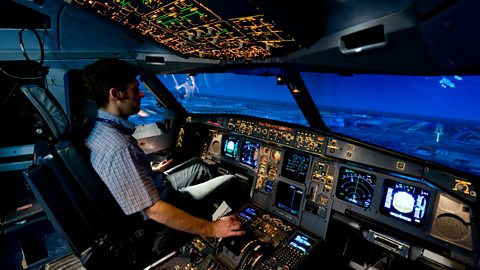Simulations
Simulations are a type of computer model. A simulation imitates a particular environment. It can be used for research or training.
Pilots are initially trained using a flight simulator. The simulator consists of a cockpit that is identical to the cockpit in a real plane. The windows are replaced with computer screens that show a simulation of the outside world. The screens, cockpit displays and controls are linked to a powerful computer that responds to the pilot. The simulation reacts based on predetermined rules linked to how the pilot behaves.

Advantages of a flight simulator
- The pilot can learn the basics without any risk of damaging the plane or injuring passengers and crew.
- It is cheaper than buying and maintaining a real plane for training purposes.
- No fuel or crew is required.
- The pilot can practise flying in dangerous weather conditions, eg heavy wind and rain.
- The pilot can practise what to do in emergencies, eg engine failure.
Other uses of simulation
- Nuclear power stations use simulation to improve output by looking at temperature, pressure and gas flow in the plant.
- Scientific experiments, eg plant growth, can be simulated in varying conditions.
- Studying the effect of the sea on the coastline in order to position defences to protect against erosion and flooding.
- Investigating the need for new roads or traffic lights by simulating traffic flow.
- The aerodynamics of cars can be investigated by simulating air flow over different body shapes.